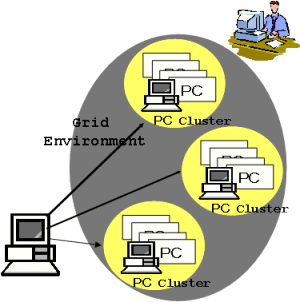
System Architecture
Heterogeneous Multi-Computer System (HMCS)
In the next generation computational physics, it is necessary to realize hybrid computations and simulations based on complex physical models containing various types of fundamental processes. In such a computational model, conventional computers built with a uniform architecture are not suitable for realizing efficient calculations. We propose a new platform named HMCS for these next generation computational physics simulations. HMCS is a conceptual framework to build systems combining vector machines, MPPs, clusters and special purpose machines, which have been used as stand-alone systems so far.
 We have constructed a prototype system based on a general purpose MPP CP-PACS and a special purpose system for gravity calculation GRAPE-6 connecting them with parallel network channels (see the figure on right), to realize a very high speed computational astrophysics simulation. In this system, two computational facilities are connected with a high bandwidth parallel I/O system PAVEMENT/PIO, and all particle data are transferred at every simulation time step. Using this system, the hydrodynamics incorporating with radiative transfer and self-gravity can be performed.
We have constructed a prototype system based on a general purpose MPP CP-PACS and a special purpose system for gravity calculation GRAPE-6 connecting them with parallel network channels (see the figure on right), to realize a very high speed computational astrophysics simulation. In this system, two computational facilities are connected with a high bandwidth parallel I/O system PAVEMENT/PIO, and all particle data are transferred at every simulation time step. Using this system, the hydrodynamics incorporating with radiative transfer and self-gravity can be performed.
Research on High Performance Cluster Computing
Recent remarkable progress in microprocessors used in PCs and workstations motivates high performance computing using clusters out of commodity microprocessors. As the performance of the microprocessor becomes comparable to that of supercomputers a decade ago, the cluster of PC connected by commodity network can achieve the same, or even higher, performance than traditional MPP systems. The PC cluster is a promising high performance computing platform to exploit the computing power of modern microprocessors for several scientific applications. While using these cluster systems to solve real computational science problems, we also study performance of clusters as the high performance computing platform of next generation, and pursue new technologies on software and networking in the following topics.
* |
OpenMP programming system using software distributed shared memory for clusters
| * |
The next generation of cluster networks using commodity network
| * |
High-density low-power cluster technology
| * |
High performance numerical libraries
|
Grid and Networks
Grid Computing Research
The platforms for computational sciences make rapid progress every year. Recently, research and development of Grid, which is a network infrastructure to utilize on-line computational facilities on wide area network, has been gathering much interest in high performance network computing. Seamlessly connecting a large number and wide range of computers from super-computers to PCs all over the world may provide enormous amount of computational power. They cover not only computationally intensive applications but also large-scale storage system, data intensive applications and software for collaborative work among researchers. As the inter-connection point of the two high-speed networks, the Super-SINET and Tsukuba-WAN, we are promoting research and development of Grid technology as a new paradigm of computational physics based on various resource sharing, for example data sharing of QCD configurations produced by CP-PACS or computing facility sharing of the special-purpose computer GRAPE.
OmniRPC:a Grid RPC system for Grid Parallel Programming
 OmniRPC is a Grid RPC system which enables seamless parallel programming in from Cluster to Grid Environment. To support typical master/worker grid applications such as a parametric execution,the OmniRPC provides °»automatic-initializable remote module°… to send and store data in the remote host. Since it may accept several requests for the subsequent calls by keeping the connection alive,the data set by the initialization is re-used, resulting in efficient execution by reducing the amount of communication. We assume that a typical grid resource is a cluster of clusters geographically distributed in several sites. For a cluster with private network, an agent process running the server host works as a proxy which relays the communications between the client and the remote executables. The OmniRPC system supports a local environment with °»rsh°…, a grid environment with Globus, and remote hosts with "ssh".
OmniRPC is a Grid RPC system which enables seamless parallel programming in from Cluster to Grid Environment. To support typical master/worker grid applications such as a parametric execution,the OmniRPC provides °»automatic-initializable remote module°… to send and store data in the remote host. Since it may accept several requests for the subsequent calls by keeping the connection alive,the data set by the initialization is re-used, resulting in efficient execution by reducing the amount of communication. We assume that a typical grid resource is a cluster of clusters geographically distributed in several sites. For a cluster with private network, an agent process running the server host works as a proxy which relays the communications between the client and the remote executables. The OmniRPC system supports a local environment with °»rsh°…, a grid environment with Globus, and remote hosts with "ssh".
Grid Applications
* |
HMCS-G° Grid-enabled Heterogeneous Multi-computer System°ň
| |
A system to access a special-purpose supercomputer GRAPE-6 for gravity calculation over Grid using the OmniRPC interface.
|
* |
CONFLEX-G(Grid-enabled Molecular Conformational Space Search Program)
| |
An exhaustive molecular conformational search program CONFLEX (developed by Dr. Goto, Toyohashi University of Technology) parallelized using OmniRPC for a grid environment. (supported by JST-ACT program of Japan).
|
* |
Parallel eigenvalue solver using Grid distributed resources: A generalized eigenvalue problem in a given domain by solving linear equations in parallel using OmniRPC.
|
|